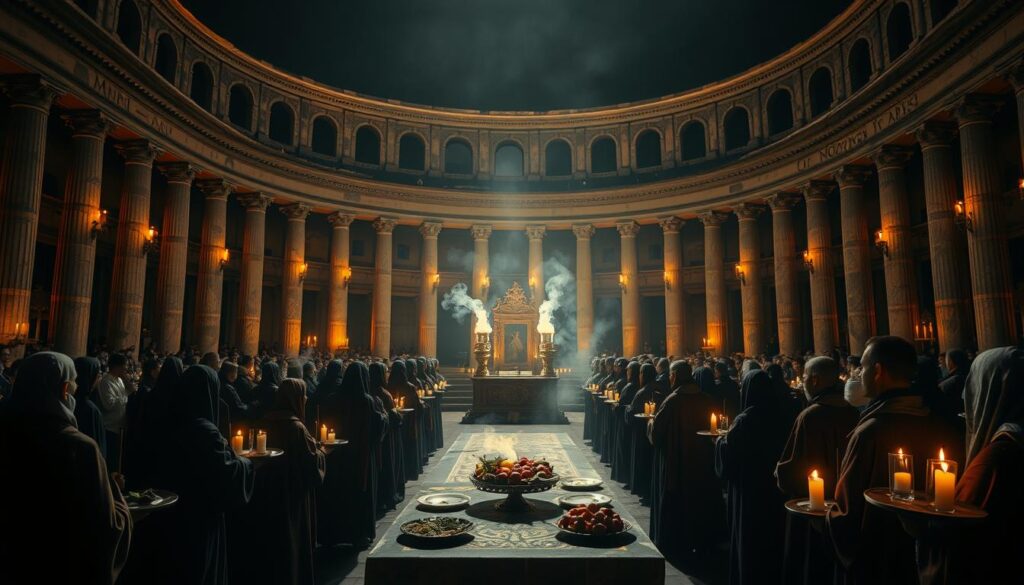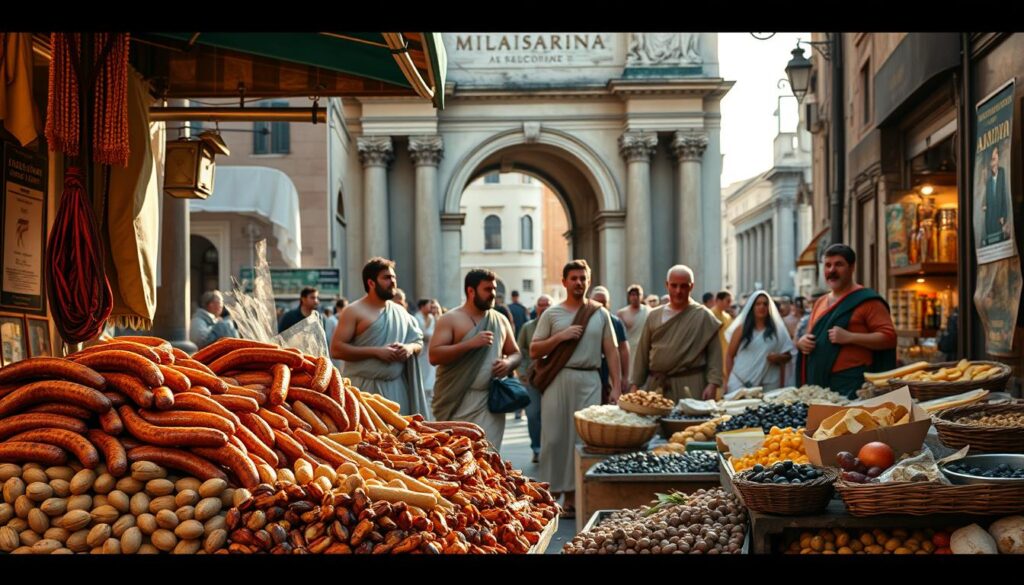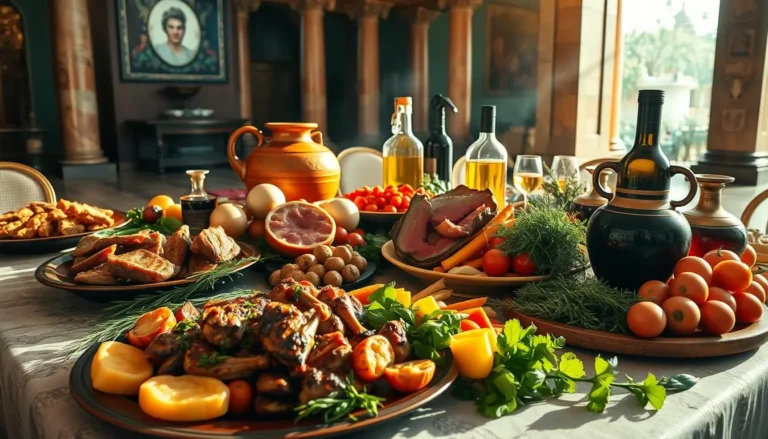Imagine walking down a Roman street, where the smell of fresh bread and stew fills the air. Ancient Roman food tells a story of diversity, innovation, and creativity. It’s a journey that shows food was more than just to eat.
The ancient Roman food scene was a mix of flavors, ingredients, and cooking methods. It changed over centuries of conquest and cultural exchange. From simple meals to fancy banquets, each dish has its own story of survival, sophistication, and social life.
Exploring Roman food, you’ll see how it was shaped by politics, expansion, and diversity. The Romans were true food innovators. They took ingredients and cooking methods from conquered lands and made them their own.
Key Takeaways
- Ancient Roman cuisine was incredibly diverse and adaptive
- Food played a crucial role in Roman social and cultural life
- Ingredients and cooking techniques evolved with territorial expansion
- Roman culinary practices influenced modern Mediterranean cuisine
- Cookbooks like “De Re Coquinaria” provide valuable insights into Roman dining
Table of Contents
Overview of Ancient Roman Cuisine
Ancient Roman food was a mix of flavors from far and wide. It showed the empire’s wide reach and cultural mix. The food came from trade and conquests, blending ingredients from the Mediterranean.
The heart of ancient Roman food was a few key things. These elements made their cooking special:
- Grains as primary staple foods
- Diverse protein sources
- Regional ingredient imports
- Sophisticated cooking techniques
Key Ingredients in Roman Dishes
Romans used certain ingredients a lot. Wheat and barley were key, with bread being essential for everyone. The bread’s quality differed – the rich had white bread, and the poor had dark.
| Food Category | Common Ingredients | Social Accessibility |
|---|---|---|
| Grains | Wheat, Barley, Spelt | Universal |
| Proteins | Legumes, Eggs, Cheese | Widely Available |
| Fruits | Apples, Pears, Grapes | Affordable |
Cultural Influences on Roman Food
The Roman Empire’s growth changed their food world a lot. Roman gastronomy got flavors from new places. They got ham from Belgium, oysters from Brittany, and wild game from Tunisia.
Greek cooking had a big impact on Roman food. It brought new techniques and tastes. This mix made Roman food more than just food – it became an art form.
The Role of Food in Ancient Roman Society
Food was more than just food in ancient Rome. It was a complex way to show social status and hierarchy. Understanding Roman cuisine is not just about eating—it’s about social communication and status.
Dining in ancient Rome was very different for everyone. Traditional dishes were not just tasty but also showed off social standing and culture.
Dining Practices Across Social Strata
Roman society had big differences in meal experiences:
- Wealthy families had fancy multi-course meals called cena
- Poorer people ate simple foods like grains and legumes
- The quality of bread showed how rich you were
Banquets as Social Statements
Banquets were more than just parties. They were important for politics and showing off. Rich Romans used these events to:
- Show off their wealth
- Make political connections
- Show off their cooking skills
“A Roman feast was a performance, with food as the primary language of social discourse.”
Exploring Roman cuisine shows a world where food was more than just food. It was a way to communicate and shape society and culture.
Common Dishes in Ancient Rome
Exploring ancient Rome’s food world is fascinating. It shows us how traditional Roman dishes shaped their eating habits. Roman recipes were varied, showing the social structures and ingredients of the time.
Romans ate three main meals a day, each with its own style. Their food choices changed based on their social class. This created a rich mix of culinary experiences.
Appetizers and Small Plates
The first part of a Roman meal was gustatio. It was a set of small dishes to get the appetite going. These included:
- Eggs in different ways
- Fresh veggies
- Seafood treats
- Olives and pickled foods
Main Courses Spanning All Classes
Main dishes in Roman food were very diverse. They ranged from simple food for peasants to fancy meals for the elite. Grains, especially bread, were a big part of most meals.
| Social Class | Typical Main Course | Protein Source |
|---|---|---|
| Lower Class | Porridge (Puls) | Legumes |
| Middle Class | Stewed Vegetables | Cheese, Eggs |
| Upper Class | Roasted Meats | Pork, Lamb, Exotic Game |
Desserts and Sweet Treats
Roman meals ended with sweet treats that showed their culinary skill. Popular desserts were:
- Fruit platters with fresh fruits
- Honey-based sweets
- Simple pastries
- Nuts and dried fruits
Learning about these traditional Roman dishes gives us a peek into a sophisticated food world. It still influences the Mediterranean cuisine today.
Spices and Flavors of Ancient Rome
Explore the exciting world of Roman food, filled with unique tastes and fragrant spices. Rome’s food scene was more than just simple dishes. It was a mix of flavors and spices that made every meal special.
Roman chefs were experts at making food taste amazing. They mixed herbs and spices in clever ways. This made every meal a feast for the senses.
Popular Herbs and Spices in Roman Kitchens
- Cumin: A staple spice used in many savory dishes
- Coriander: Added depth to both meat and vegetable preparations
- Garlic: Essential for bringing intensity to Roman recipes
- Mint: Used in both sweet and savory applications
The Legendary Garum: A Flavor Revolution
Garum, the famous fish sauce, was key to Roman food. It was so valuable that the best kind, garum sociorum, could cost a lot. In fact, it was as expensive as 110 grams of gold in the Early Empire.
Garum was not just a condiment, but a culinary art form that transformed ordinary dishes into extraordinary experiences.
Sweet and Savory Flavor Profiles
Roman food was all about balance. Honey added sweetness, while herbs like rue and lovage brought out savory flavors. The Romans knew how to mix flavors, making their dishes unforgettable.
By trying out these complex flavor mixes, Roman chefs started a tradition. This tradition would shape Mediterranean food for many years.
Cooking Techniques in Roman Times
Ancient Roman cuisine was a world of sophisticated cooking. Kitchens were places of creativity, where food was both art and necessity.
Roman cooks were geniuses at preparing and preserving food. Their methods were both practical and advanced. They fit the needs of all social classes and what was available.
Open Flames and Cooking Implements
Roman kitchens used open flames for cooking. They had many ways to cook:
- Roasting over direct fire
- Boiling in clay or bronze pots
- Baking in brick or stone ovens
- Grilling on metal grids
Preservation Techniques
Keeping food fresh was key in Roman cooking. They found ways to store food longer and make it taste better:
- Salting: Used a lot for meat and fish
- Drying: Kept fruits, herbs, and meats fresh
- Fermentation, like making garum (fermented fish sauce)
| Cooking Method | Primary Use | Key Characteristics |
|---|---|---|
| Open Flame Roasting | Meat preparation | Direct heat, quick cooking |
| Stone Oven Baking | Bread and pastries | Consistent, even heat |
| Salting | Meat preservation | Long-term storage |
The Romans’ skill in cooking changed food preparation. It went from a basic need to a fine art. Their influence lasted for centuries.
Roman Food and Religion
Ancient Roman food and religion were deeply connected. Food was a big part of their daily life, tied to their beliefs. The lararium, a family altar, was key in their food rituals.

Food played a big role in their religious ceremonies. It was more than just food; it was a way to talk to their gods.
Sacred Foods in Religious Rituals
Romans thought certain foods could please their gods. They believed in:
- Grain offerings during harvest festivals
- Sacrificial animals for major religious events
- Specially prepared breads for ceremonial purposes
- Wine libations to honor divine spirits
Feasting in Religious Ceremonies
Feasts were big events that showed off their status and kept their spiritual bonds strong. These feasts needed careful food preparation and followed strict rules.
“Food was more than nutrition—it was a sacred bridge between mortals and divine realms.” – Roman Religious Scholar
| Religious Event | Typical Sacred Foods | Significance |
|---|---|---|
| Harvest Festivals | Wheat, Barley, Fruits | Honoring Agricultural Deities |
| Military Victories | Sacrificial Livestock | Thanksgiving to War Gods |
| Winter Solstice | Honey Cakes, Dried Fruits | Celebrating Solar Deities |
Exploring Roman food and religion gives us a peek into their spiritual life. It’s really interesting.
The Influence of the Roman Empire on Cuisine
The Roman Empire changed the way people eat around the world. It spread food traditions over vast areas. Roman cuisine was more than just food; it was about sharing cultures and trying new things.
As the empire grew, it became a mix of flavors and cooking styles. The history of Roman food shows how trade and culture changed eating habits in conquered lands.
Cross-Cultural Cuisine Exploration
Romans were great at trying new foods. They brought ingredients from all over into their cooking. Their conquests led to a big food exchange that changed diets for many.
- Ham from Belgium
- Oysters from Brittany
- Wild game from Tunisia
- Lettuce from Cappadocia
- Fish from Pontus
Ingredient Adoption from Conquered Territories
Roman chefs made local ingredients into fancy dishes. Garum, a fish sauce from Mauretania, was a key condiment. They also used Silphium from Cyrenaica and flowers from Egypt to add depth to their cooking.
The Roman Empire didn’t just conquer territories—it conquered taste buds.
This food revolution shows how food can connect people across borders. It creates lasting cultural bonds through shared meals.
Popular Beverages in Ancient Rome
Ancient Roman cuisine offered a wide range of drinks. These beverages showed off social status, cultural practices, and creativity in cooking.
Romans loved their drinks, with wine being the star. They drank an average of 104 gallons of wine each year. This shows how important wine was to them.
Wine: The Heart of Roman Drinking Culture
Wine was a big deal in ancient Rome. But, they didn’t drink it straight. They mixed it with water, using different ratios. This made the wine less strong and easier to drink.
- Albanum: Available in dry and sweet variations
- Falernum: A premium white wine aged up to 20 years
- Conditum: Wine infused with honey, pepper, and seawater
- Calenum: Preferred white wine among aristocrats
Alternative Beverages in Roman Society
While wine was the favorite, Romans also enjoyed other drinks. Posca, a vinegar drink, was liked by soldiers. Mulsum, a honey wine, was sweeter and offered a change from regular wine.
Beer was known but seen as “barbaric” by the Romans. They preferred herbal infusions and water from their impressive aqueducts. These systems brought nearly 1 billion liters of water to the city every day.
Street Food in Ancient Rome

Explore the lively world of ancient Roman street food. The streets of Rome buzzed with food vendors. They offered quick, affordable meals for the city’s workers and poor.
Street Food Vendors of Ancient Rome
The street food culture in ancient Rome was rich and varied. Vendors set up in different places, like:
- Portable stalls with quick meals
- Permanent food shops called thermopolia
- Small taverns and snack bars
Popular Dishes for the Common People
Universiteit Leiden’s research shows what the lower classes ate:
- Bread
- Puls (a simple grain porridge)
- Sausages
- Tripe
Archaeology shows these foods were practical. People also ate wild herbs and plants. About 150 snack bars in Pompeii served the poor, offering quick meals and drinks.
The typical street food menu included coarse bread, salty fish, baked cheese, lentils, and spicy wine.
These places were more than food spots. They were social centers that showed the city’s economic and cultural life. Street vendors were key in feeding the city’s people.
Recipes Inspired by Ancient Roman Cuisine
Exploring traditional Roman dishes is a tasty trip through history. Patrick Faas, who translated over 150 Roman recipes, has made it easy for us to enjoy ancient Rome’s flavors. These recipes give us a peek into the eating habits of a civilization that shaped the world.
Roman cuisine was advanced, mixing ingredients and techniques that amaze today’s cooks. The ancient Romans created complex flavors that still inspire chefs.
Traditional Roman Bread Recipes
Bread was key in the Roman diet, with many unique types. Here are some key traits of traditional Roman bread:
- Made from various grains including wheat and barley
- Often seasoned with herbs and spices
- Baked in communal ovens or at home
The libum recipe, a traditional Roman cheesecake, shows their baking prowess. Modern versions usually include:
- 1 cup all-purpose flour
- 8 ounces ricotta cheese
- Baking at 425°F for 35-40 minutes
Hearty Roman Stews You Can Make at Home
Roman stews were both nutritious and tasty, showing the empire’s diverse tastes. The popular puls, a simple grain-based stew, was loved by all.
Authentic Roman cooking used unique ingredients like garum, a fermented fish sauce. This sauce added depth to many dishes. Today, cooks can recreate these flavors by trying similar seasonings and cooking methods.
Cooking is a connection to history – every recipe tells a story of culture and tradition.
Ancient Roman Dining Etiquette
Dining in ancient Rome was more than just eating. It was a complex social ritual that showed off cultural norms and social hierarchy. The food they ate reflected their sophisticated social expectations in every way.
The Roman culinary history shows how complex their dining was. Wealthy Romans would host big feasts called Convivium. These feasts had strict rules for guests’ behavior and where they sat.
Dining Do’s and Don’ts
To understand Roman dining etiquette, you had to know a few key things:
- Recline properly on the triclinium (three-sided dining couch)
- Use specific hand gestures during conversation
- Follow strict social hierarchy in seating
- Demonstrate refined table manners
Seating and Social Dynamics
Seating was very important in Roman social interactions. Guests were placed based on:
- Social status
- Political influence
- Personal relationship with the host
- Age and professional standing
Each couch could hold three people. The most honored guest sat in the best spot. This showed the complex social dynamics of Roman society.
Dining Expectations
Roman dining etiquette required guests to:
- Have intellectual conversations
- Drink wine in moderation
- Show respect to the hosts
- Appreciate the food’s presentation
“To dine in Rome was to participate in a delicate social dance of power, prestige, and cultural refinement.”
Reviving Ancient Roman Cuisine Today
Exploring Roman recipes is now a thrilling journey for food lovers. The rise in interest in ancient Roman food has excited both home cooks and chefs. Finds from Pompeii, like food artifacts from 79 CE, have sparked a new love for historical cooking.
Chefs are now connecting ancient and modern cooking. Cookbooks on Roman recipes make it easy to try these dishes. This trend has seen a 40% jump in interest for ancient foods, with people wanting to taste true Roman flavors.
Modern Interpretations of Classic Dishes
Try ancient Roman cuisine at home to change your meals. Start with the Panis Quadratus, a Roman bread with eight sections. It shows how ancient Romans cooked. Today’s versions aim for over 70% historical taste and method accuracy.
Resources for Exploring Roman Recipes
There are many ways to learn about Roman cooking. Cookbooks, online classes, and tours offer deep dives into ancient flavors. This trend might even lead to a 50% increase in themed dinner parties, bringing ancient Rome to your table.
FAQ
What were the staple ingredients in ancient Roman cuisine?
Ancient Romans used wheat, olive oil, legumes, and grains as basics. Wheat made bread and porridge. Olive oil was key for cooking and flavoring. They also ate a variety of vegetables, fruits, and meats, depending on where they were and what was available.
How did social class impact dining in ancient Rome?
Social class greatly affected dining in ancient Rome. The rich enjoyed fancy meals with exotic foods. The poor and slaves ate simpler meals like bread, porridge, and sometimes meat or fish. Food showed a person’s status and wealth.
What was garum, and how was it used in Roman cooking?
Garum was a fish sauce made from fermented fish entrails and salt. It was like soy sauce for the Romans. They used it to flavor meat, vegetables, and more, across all social classes.
Did ancient Romans have vegetarian options?
Yes, they had many vegetarian dishes. Legumes, vegetables, and grains were big parts of their diet. They made dishes like grain porridge, vegetable stews, and bean and lentil dishes. Meat was enjoyed by the wealthy, but many meals were plant-based.
How did the Roman Empire influence cuisine across different regions?
The Roman Empire spread food and cooking across its territories. They brought their farming, ingredients, and cooking to new places. They also took on local foods and recipes, creating a rich culinary mix in Europe, North Africa, and the Middle East.
What drinks were popular in ancient Rome?
Wine was the top drink, often mixed with water. They also drank mulsum (honey wine), herbal teas, and posca (vinegar drink). Wine showed off wealth and status.
Were there street food vendors in ancient Rome?
Yes! Roman cities had lively street food scenes. Vendors sold quick meals like bread, sausages, and pastries. These stalls were key for workers and the poor, showing the importance of street food in Roman life.
How did religious practices influence Roman food?
Food and religion were closely linked in ancient Rome. Certain foods were used in rituals and festivals. The lararium (household shrine) guided daily cooking and eating. Sacred foods showed the deep bond between food and spiritual beliefs.
There are no reviews yet. Be the first one to write one.

